What Should The Setting Be To Get Everything In Focus With The Nikon D750 Camera
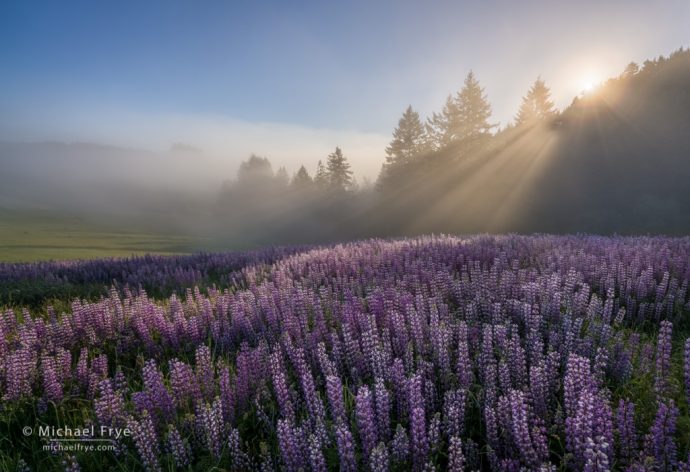
Sun ascent over a field of lupines, Redwood NP, California. The focal length was 16mm, and the closest objects to the camera were the flowers at the very bottom of the frame, about two feet from the lens. I used my hyperfocal-distance shortcut to detect the optimum focus distance, by doubling the distance from the closest object and focusing at four feet. Then I stopped to down to f/16 to get enough depth of field to make both the foreground and background precipitous. 16mm, three bracketed exposures at f/xvi, ISO 100, blended with Lightroom'due south HDR Merge.
In this contempo mail I talked near the importance of having a solid, well-practiced field routine, so that you lot don't forget important steps, and y'all'll be less likely to panic when the light gets interesting.
One of the steps in my routine, focusing, deserves a little more attention, and so I'm going to comprehend that step in more than detail hither.
(In that previous post I covered some of the basics nearly focusing and finding the hyperfocal distance. The adjacent section repeats some of that data, but with additional details. If y'all don't want to become over that territory again, still, experience free to skip down to the department below called "When the Hyperfocal Distance Doesn't Apply.")
Some Basics
First, allow's assume that yous want to get everything in focus (which probably applies to 99% of landscape photographs). If everything in the photograph is far away, focusing can be like shooting fish in a barrel. All the objects in the picture are substantially at infinity as far as the lens is concerned, so the focus distance for everything is the same. You can focus on whatsoever part of the frame, either manually or with autofocus, and be sure that you're focusing at the right distance.
How far away am I talking about? That depends on the lens. Y'all probably know that information technology'south easier to get everything in focus with broad-bending lenses than telephoto lenses. If you're using a wide-angle lens (say 28mm or wider), information technology's safe to say that if everything in the photograph is at least 50 feet away, so y'all don't have to worry about depth of field, and you can focus anywhere in the frame. With a 50mm lens that "safe" distance is about 100 feet. With a 100mm lens information technology'southward more like 250 anxiety. (These distances use regardless of the sensor size, or ingather factor. Simply the actual focal length matters.)
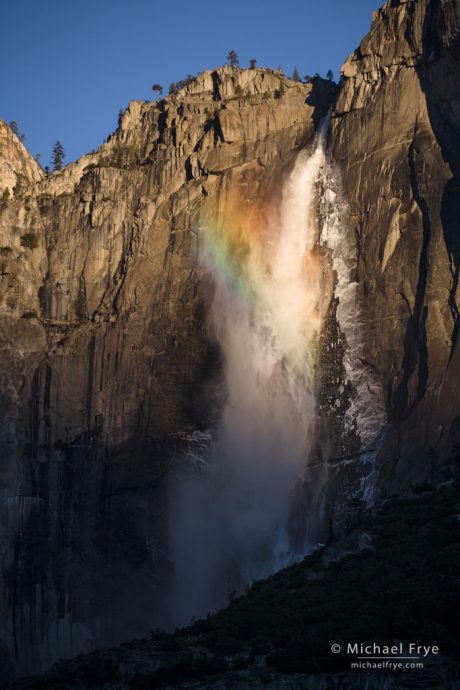
Upper Yosemite Autumn and rainbow, Yosemite. Although I used a telephoto lens (145mm) for this photograph, the cliffs and waterfall were at to the lowest degree half a mile from the camera – essentially at infinity as far as the lens was concerned. And so focusing was easy; I could autofocus anywhere, knowing that every section of the photograph was at infinity, then the focus distance for everything was the same. And since the depth of field was minimal I could use f/v.six, a adequately broad aperture, and all the same exist sure of getting everything in focus. 145mm, 1/180th sec. at f/5.6, ISO 200.
If there's something in the frame that's closer than that, y'all accept to be more careful about where yous focus.
Permit'southward say you lot've composed a photograph with a 24mm lens, where the closest object to the camera is iii feet away, and the farthest object is at infinity. That'southward a lot of depth, even for a broad-angle lens, so precise focusing is critical. Where (at what distance) should y'all focus? The short answer is: somewhere in betwixt, and closer to the foreground than the groundwork. (There's more depth of field backside the spot y'all focus on than in front, so focusing closer to the foreground will allow you to stretch the depth of field to cover both the closest and farthest objects.)
Can we get more precise than that? Absolutely. You lot could use a hyperfocal-distance nautical chart or app, but I find these cumbersome and slow.
You could use an aphorism like, "focus a third of the fashion into the frame," or "focus a third of the way from the bottom of the frame." These both have grains of truth, and piece of work some of the time, but don't work at all for many situations.
Finding the Hyperfocal Distance
And then we need something amend. Here's a shortcut that I use all the time: the hyperfocal distance is approximately double the distance from the closest object to the lens. So if the closest object to the lens is three anxiety abroad, so the hyperfocal distance is six feet. If the closest object is 10 anxiety away, then the hyperfocal distance is twenty feet. Elementary, correct?
(Note that the hyperfocal altitude is the optimum focusing altitude for getting everything in focus from the foreground to infinity. It doesn't apply to situations where the background isn't at infinity, like if y'all're trying to become everything from 10 feet to thirty anxiety in focus. For those instances, see the department "When the Hyperfocal Altitude Doesn't Employ" beneath.)
So in the example above, if I'm trying to get everything from three feet to infinity in focus with a 24mm lens, where should I focus? I just double the distance from the closest object – three anxiety – and focus at six feet. (You can apply the distance scale on the lens for this, or just choice a spot 6 feet away and focus on it, either manually or with autofocus.)
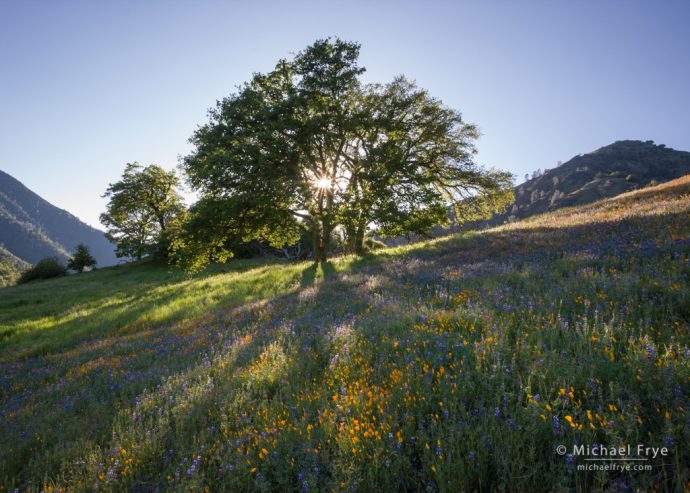
Poppies, lupines, and oaks, belatedly afternoon, Sierra Nevada foothills, California. Once more I used my hyperfocal-altitude shortcut to find optimum focus distance. The closest objects, the flowers in the lower-right corner of the frame, were almost 3 feet from the lens, so I doubled that distance and focused at six feet. 17mm, 1/30th sec. at f/16, ISO 400.
There are limits of class. Fifty-fifty with a broad lens, like 24mm, I can't get everything from six inches to infinity in focus in one frame. Here are some practical limits for getting everything in focus with various focal lengths at f/sixteen (the smallest aperture I'yard willing to utilize before diffraction becomes objectionable). (I'grand using a depth of field app to calculate this, with a circle of confusion of .02mm, which matches my applied experience with today's high-resolution sensors.)
16mm: 1.five anxiety to infinity (at f/xvi, focused at 3 feet)
20mm: two feet to infinity (at f/16, focused at 4 anxiety)
24mm: 3 feet to infinity (at f/sixteen, focused at half-dozen feet)
35mm: six feet to infinity (at f/16, focused at 12 feet)
50mm: 13 anxiety to infinity (at f/16, focused at 26 feet)
100mm: 50 anxiety to infinity (at f/16, focused at 100 feet)
200mm: 200 anxiety to infinity (at f/16, focused at 400 feet)
You don't accept to memorize this (though that wouldn't hurt). I'thousand simply trying to show you the limits of what'due south possible. You're just not going to be able to everything from 10 feet to infinity in focus with a 100mm lens (at to the lowest degree non with i frame).
When the Hyperfocal Altitude Doesn't Employ
The hyperfocal distance is the optimum focusing distance for getting everything in focus from the foreground to infinity. But what if the background isn't at infinity? What if y'all're trying to get a range from, say, ten anxiety to 30 feet in focus?
Let'due south become back to one of those aphorisms for a minute – the one that says "focus a 3rd of the mode into the frame." I tin't see how this axiom applies when the background is at infinity. For case, if the closest object to the camera is three feet away, and uttermost object iii miles abroad, then should yous focus one mile away? No, of form not – that would be at infinity as far as the lens is concerned. You demand to focus a lot closer than that.
But this axiom is actually pretty accurate when when dealing with finite distances (in other words, when the far distance isn't infinity). For example, if you're trying to get a range from 20 anxiety to 50 feet in focus, then focusing a third of the way between those two distances would bring you to 30 feet, which is simply near right. Yous still accept to judge those distances, which I often notice difficult, but information technology might at to the lowest degree go you into the ballpark.
What about that other aphorism, "Focus a third of the way from the bottom of the frame?" That idea also can piece of work if yous're photographing apartment ground that recedes into the distance evenly (like a meadow, field, playa, etc.) But if you have objects in front of other objects (like trees in front of other trees), it doesn't work at all.
A Technique for Whatever Situation
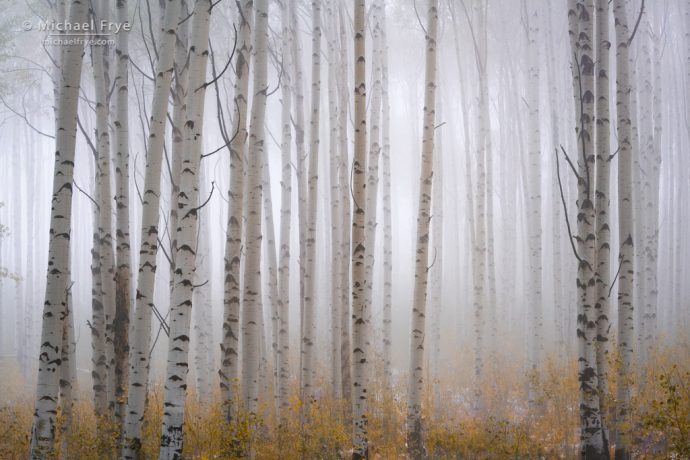
Aspens in fog, White River NF, Colorado. I used the "quick-and-muddy method," described below, to find the optimum focus altitude for this scene. 70mm, 1/6th sec. at f/xvi, ISO 200.
Instead, here's a technique I've been using for decades that works in any situation, whether the range you're trying to arrive focus is 3 anxiety to infinity, or 3 inches to nine inches. And it works even when you have objects stacked in front end of each other.
The basic concept is pretty elementary. You focus on the closest thing to the camera, then focus on the farthest object, then heart the focusing ring halfway in betwixt those distances. Not halfway out in the field, but halfway between the distance marks on the lens.
Allow's say I focus on the closest thing to the photographic camera, and find out, according to the distance scale on my lens, that it's 7 feet away. So I focus on the uttermost object, and see that information technology'south xx feet abroad. To find the optimum focusing point, I but manually turn the focus ring until it shows that I'm halfway betwixt the 7-foot mark and the 20-foot marking on the distance scale of the lens, like this:
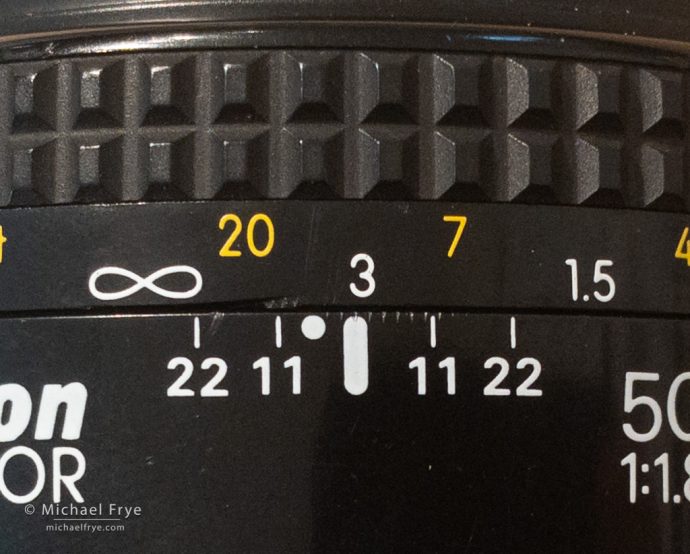
If the closest object to the camera is seven anxiety abroad, and the farthest object is xx feet away, then I focus halfway between those two marks on the lens. In this example I ended up focusing simply by the 3-meter mark, at approximately 11 feet.
What if the closest or uttermost distances don't conveniently align with one of the foot or meter marks on the focusing ring? First, I focus on the closest affair to the camera, and marking that altitude on the focusing ring with a fingernail. And so I focus on the farthest object, and mark that with another fingernail. Then I focus halfway between my fingernails, like this:
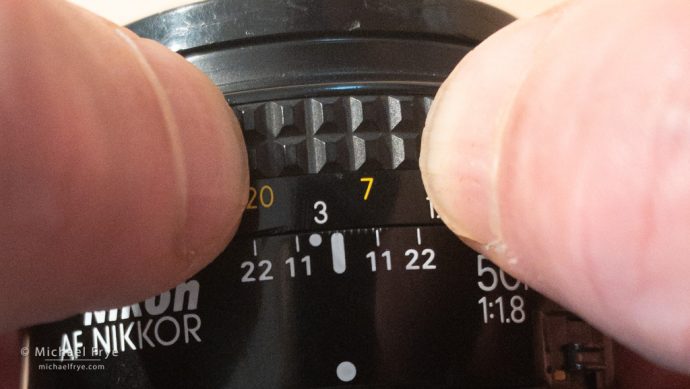
Instead of using pes or meter marks on the lens, you tin but mark the closest and furthest points with your fingernails.
The Quick-and-Dirty Method
The technique I merely described works actually well if your lens actually has a distance calibration. Unfortunately, many modern lenses don't. Then then what practice yous do? Try the "quick-and-muddied method."
Once again, use transmission focus. Look through the viewfinder, and focus on the closest object to the photographic camera. Next, focus on the farthest object from the camera. Then, however looking through the viewfinder, rock the focusing ring most halfway between those ii distances. (Again, I'm talking about the distance you're turning the focusing ring, not the distance betwixt objects in the field.)
Check yourself past seeing if the foreground and background await every bit out of focus. In other words, if the foreground looks sharper than the background, you've focused as well close. If the background looks sharper than the foreground, you've focused too far. If both the foreground and background await every bit fuzzy, then you lot've focused at the right altitude. (I call this the Equally Fuzzy Principal.)
Here's an example of the quick-and-dirty method. For this patch of flowers in our chiliad I first focused on the closest matter to the camera – the flowers in the lower-left corner of the frame:
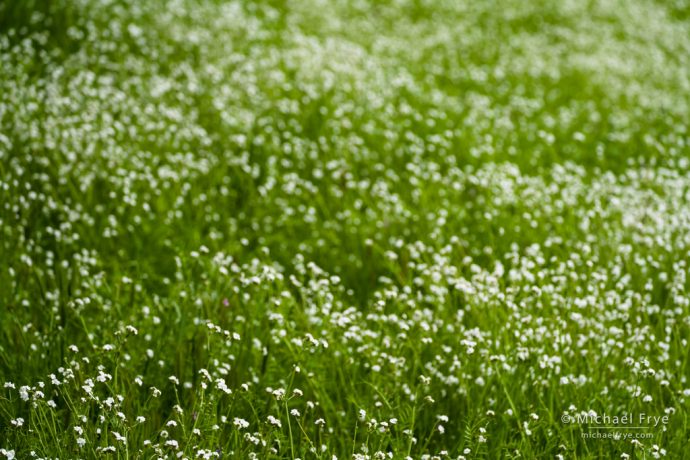
To use the quick-and-dirty method you kickoff focus on the closest thing to the photographic camera – in this instance, the flowers in the lower-left corner.
Adjacent, I focused on the farthest thing from the photographic camera – the flowers in the upper-right corner:
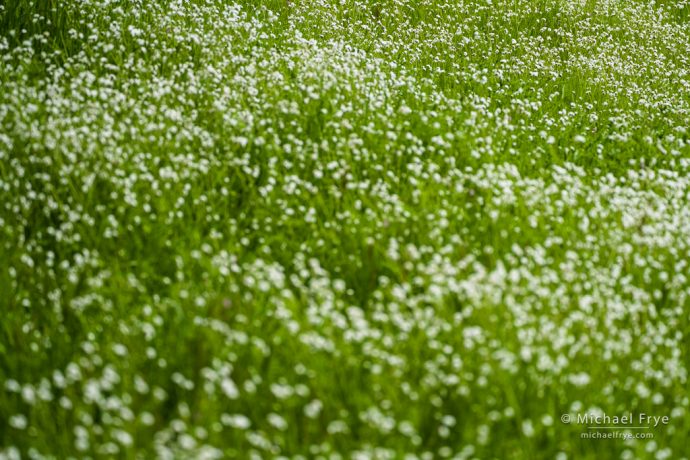
Adjacent yous focus on the farthest matter from the camera – hither, the flowers in the upper-right corner.
Then I rocked the focusing ring virtually halfway betwixt, and checked to see if the foreground and groundwork were as out of focus. Hither, the flowers in the lower-left corner expect about every bit fuzzy as the flowers in the upper-right corner, so it looks similar I'thou focused in the right spot:
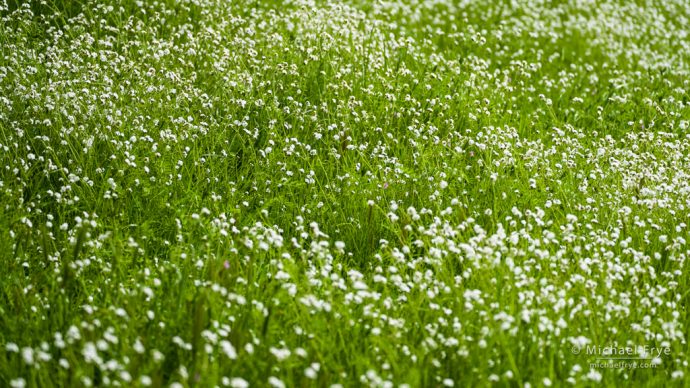
So you rock the focusing ring about halfway in between, until the foreground and background await well-nigh equally fuzzy.
Here's a short video that demonstrates this technique:
(If you lot can't see the video, click here.)
I actually utilise this quick-and-dirty method more than often than marking the distances on my lens, fifty-fifty if my lens has a distance scale. It'southward faster.
Notwithstanding, for this quick-and-muddied method to work the aperture has to be wide open up, otherwise information technology's hard to see what's in focus and what's not. This isn't a concern with SLRs, since the lens diaphragm stays open until yous printing the shutter. So even if you lot have the discontinuity prepare to f/xvi, the diaphragm will actually exist wide open at f/two.eight or f/4 (or any your lens's widest aperture is) until you printing the shutter. This broad-open viewing aperture makes the depth of field shallow, allowing yous to see what'due south in focus more readily.
But with some mirrorless cameras the lens may really be stopped down even earlier yous press the shutter – depending on the camera and its settings. I can't become into detail nearly every camera here, but I'll mention that with a Sony mirrorless cameras and Sony lenses, the aperture is usually stopped down even before you press the shutter. So if y'all've prepare a smaller aperture like f/11 or f/16 information technology becomes difficult to come across precisely where you've focused, because there'southward and so much depth of field.
To modify that you can either only manually adjust the f-end to your widest aperture to focus (and then reset information technology to accept the picture), or, in the menu, under Live View Brandish, turn the Setting Event to Off, which makes the camera behave like an SLR past keeping the diaphragm open until you press the shutter. (Annotation that I recommend usually having the Setting Result on, so that you get a live preview of your exposure. I put the Live View Brandish menu item in my Role menu for quick access, then I can turn the Setting Outcome off and dorsum on when needed.)
Naturally, whatsoever of these techniques take practice. Y'all can practice focusing in your lawn – and now might be a proficient fourth dimension to do that.
Setting the Aperture
Once yous've found the optimum focusing altitude, using any of the methods described above, then you need to pick an aperture, take the pic, and check sharpness.
Picking the discontinuity is really pretty piece of cake. For 95% of my photographs I employ either f/xi or f/16.
If everything in the scene is far enough abroad to exist at infinity, then depth of field isn't an issue. You lot could utilise whatsoever aperture, so you lot may besides pick the f-stop where your lens is sharpest. For most lenses that's in the center range, somewhere between f/5.6 and f/11. I usually use f/11 to make sure I have enough depth of field. I might use f/viii or f/five.6 if everything is actually far away, and I remember my lens volition exist sharper at one of those wider apertures.
If the scene has some depth to information technology – plenty depth to crave focusing precisely, equally described at length above – then I'll use f/16. That'due south the smallest discontinuity I'one thousand willing to use earlier diffraction becomes objectionable. (For more than well-nigh that topic, meet this post.)
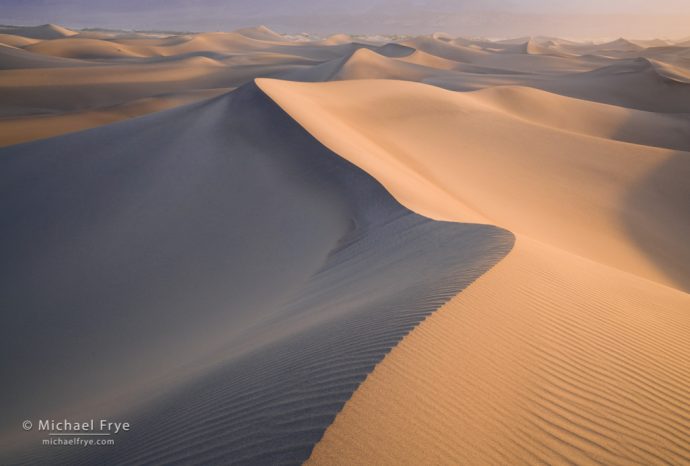
Sand dunes, Mesquite Flat Dunes, Death Valley. When a scene has some depth, similar this one, I typically use f/sixteen – the smallest discontinuity I'm willing to use before getting objectionable diffraction. Here the focal length was 33mm, and the closest thing to the camera was the sand at the bottom of the frame, which was virtually 5 feet away. So I focused at double that distance (about ten anxiety), and used f/16 to get sufficient depth of field. 33mm, 1/8 sec. at f/16, ISO 100.
Then take the picture, magnify the paradigm on the back of the camera, and check to see if everything is in focus. If everything looks precipitous, great – y'all're washed. If the foreground is abrupt but the background is soft, then you lot've focused to close; arrange your focus and effort again. If the background is sharp merely the foreground is soft, and then you lot've focused also far; arrange your focus and endeavor again. If the center is sharp, but both the foreground and background look soft, and so you're focused at the right distance, only you didn't accept sufficient depth of field. Attempt using a smaller aperture, or, if that doesn't work, you'll need to focus stack.
Manifestly y'all need to set your exposure fashion to either aperture-priority or manual to perform this step!
So that's it. I know this is a lot to assimilate, but I wanted to be thorough, and give yous a number of options and so that you tin can pick what works all-time for you. Good luck – and don't forget to practice!
— Michael Frye
Related Posts: Developing a Solid Field Routine; Focus-Stacking Season; Why F/16?
Michael Frye is a professional person photographer specializing in landscapes and nature. He is the writer or principal photographer of The Photographer'south Guide to Yosemite, Yosemite Meditations, Yosemite Meditations for Women, Yosemite Meditations for Adventurers, and Digital Landscape Photography: In the Footsteps of Ansel Adams and the Great Masters. He has too written iii eBooks: Light & Land: Landscapes in the Digital Darkroom, Exposure for Outdoor Photography, and Landscapes in Lightroom: The Essential Step-past-Step Guide. Michael has written numerous mag manufactures on the art and technique of photography, and his images take been published in over thirty countries around the world. Michael has lived either in or about Yosemite National Park since 1983, currently residing just outside the park in Mariposa, California.
Source: https://www.michaelfrye.com/2020/04/20/how-to-get-everything-in-focus/
Posted by: murphyotibitepar.blogspot.com

0 Response to "What Should The Setting Be To Get Everything In Focus With The Nikon D750 Camera"
Post a Comment